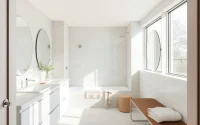Transform Your Space with the Elegance of Water Vapor Fireplaces
Understanding Water Vapor Fireplaces
What is a Water Vapor Fireplace?
A water vapor fireplace is a modern innovation in the realm of home heating and decorative elements. Unlike traditional wood or gas fireplaces that generate real flames, a water vapor fireplace employs ultrasonic technology to create a realistic flame-like effect. This system produces a fine mist of water vapor that is illuminated by LED lights, creating a visually stunning and safe alternative for enjoying the ambiance of a fire indoors.
The essence of a water vapor fireplace lies in its ability to offer an aesthetic appeal comparable to real flames without the associated risks. This technology is particularly appealing in contemporary home designs and minimalist aesthetics, where the focus is on creating an inviting atmosphere without the clutter of traditional fireplace installations.
How Do Water Vapor Fireplaces Work?
Water vapor fireplaces utilize an ultrasonic transducer that vibrates at high frequencies, which converts water in a reservoir into a fine mist. Upon activation, this mist interacts with bright LED lights, which shine through the vapor to create a mesmerizing illusion of flames that flicker and dance, resembling the appearance of a traditional fire.
This mechanism operates silently and without combustion, thus eliminating the emission of harmful gases or pollutants. The setup includes a water reservoir that needs to be filled, and some models may even feature automatic refilling systems. For users requiring a constant flame effect, connecting the unit to an ongoing water supply is often advised.
The Technology Behind the Flame Illusion
The realistic flames of a water vapor fireplace are attributed to sophisticated LED lighting systems complemented by well-engineered mist generation technologies. Innovations in lighting such as color-changing LEDs enhance the visual experience by simulating the colors of real flames. These technologies can be programmed to adjust brightness, height, and even create different flame colors, giving users the ability to personalize the atmosphere of their space.
Moreover, with advancements in design, modern water vapor fireplaces are crafted with a focus on realism. Many models incorporate features such as ember beds or crystal displays that reflect and refract light, further adding to the authentic look of burning wood or coal. This high level of detail is not just for aesthetics; it’s engineered for the user experience, making the fireplace a focal point of the room.
Benefits of Water Vapor Fireplaces
Safety and Environmental Impact
One of the most significant advantages of water vapor fireplaces is their inherent safety. Without real flames or hot surfaces, they pose minimal risks of burns or fire hazards, making them ideal for homes with children and pets. The cool-to-the-touch vapor allows for peace of mind while delivering the visual comfort of a fire. Furthermore, because they do not burn wood or gas, water vapor fireplaces produce no harmful emissions, contributing to improved indoor air quality.
Environmentally, using water vapor fireplaces can contribute to sustainability efforts. They avoid the carbon footprint associated with traditional fossil fuel combustion and are an energy-efficient way to enjoy a fireplace ambiance with much lower energy consumption than traditional heating systems.
Creating Ambiance Without Real Flame
Water vapor fireplaces excel in providing the intimate atmosphere typically associated with real flames. The visual appeal of flickering vapor combined with adjustable LED options allows users to tailor their experience based on mood and occasion. This feature is especially advantageous for those living in apartments or urban environments where traditional fireplaces may not be feasible.
Additionally, these units often act as a decorative focal point, adding a sophisticated touch to interiors. Whether integrated into walls, standalone units, or designed as centerpiece coffee tables, water vapor fireplaces serve both functional and aesthetic needs.
Versatility and Design Options
Water vapor fireplaces come in various styles, sizes, and forms, making them suitable for almost any interior design. From sleek and minimalistic designs to more ornate setups that resemble traditional fireplaces, there’s a water vapor fireplace to complement every décor. Many models can be customized to fit specific dimensions or integrate seamlessly into cabinetry, wall features, or even existing fireplaces.
Moreover, because they require no flue or chimney, homeowners can install them in locations that were previously not conducive to traditional fireplaces, such as open spaces, corner alcoves, or even near sensitive materials. This flexibility allows for creative installations and opportunities to enhance living spaces creatively.
Installation and Maintenance
Installation Considerations for Your Home
Installing a water vapor fireplace is generally more straightforward than its traditional counterparts due to the lack of ventilation requirements. Users can install these units in various locations that suit their aesthetic and functional needs. Most models only need access to a power supply and water source, making it imperative to consider the location concerning these utilities. Users opting to connect to a water line can eliminate the hassle of constantly refilling the tank, but for those in situations where this is not feasible, selecting a model with an adequately sized reservoir for easy maintenance is essential.
Additionally, while the installation process is relatively simple, it is crucial to follow the manufacturer’s guidelines regarding safety and placement. In some cases, consulting with a professional can ensure optimal setup and function, especially in multi-function installations such as walls or custom cabinetry.
Maintenance Tips for Optimal Performance
Regular maintenance is necessary for ensuring the operational efficiency of a water vapor fireplace. While these units require less upkeep than traditional fireplaces, users should periodically clean the fluid reservoir and ultrasonic components to prevent mineral buildup and maintain vapor quality. Typically, cleaning every two weeks is recommended, and using distilled water can help minimize scale deposits.
Furthermore, checking the LED lights for any failures and replacing them promptly will ensure the fireplace maintains its aesthetic appeal. Users are encouraged to consult their manual for specific maintenance routines tailored to their model.
Potential Issues and Solutions
As with any appliance, potential issues can arise with water vapor fireplaces. One common problem may be insufficient mist production or vapor quality. This can often be attributed to hard water usage, which contributes to mineral buildup in the system. Switching to distilled water and routinely cleaning the components can resolve these issues effectively.
Another potential challenge is the reliance on electricity, which means these fireplaces will not operate during power outages. Homeowners should weigh this factor, especially in regions prone to such circumstances. For those who frequently experience outages, exploring models with battery backup options or alternative heating sources may be prudent.
Comparing Water Vapor Fireplaces to Traditional Options
Heat Output vs. Aesthetic Appeal
While traditional fireplaces are celebrated for their heat output and the genuine warmth they provide, water vapor fireplaces stand out in the aesthetic realm. They prioritize design and ambiance over actual heat generation, making them ideal for users seeking a decorative element more than a heating source. Homeowners in milder climates or those who already have adequate heating systems might find the allure of a water vapor fireplace perfectly aligned with their needs.
In contrast, traditional fireplaces can enhance the overall temperature of a room significantly, which serves practical purposes for those relying on them for heating. As such, understanding individual needs and expectations is essential in making the right choice between these two types of fireplaces.
Cost Analysis: Initial and Long-term
When considering costs, it is essential to examine both initial installation and long-term operating expenses. Water vapor fireplaces typically have a higher upfront cost than traditional electric fireplaces; however, they may yield savings in energy consumption over time due to their efficient operation. Additionally, water vapor fireplaces can on average be easier and less costly to maintain, as there is no need for chimney cleaning or additional structural support.
Conversely, traditional fireplaces can involve continuous fuel costs, and they require more frequent servicing. Therefore, users must evaluate their budget and long-term living situation comprehensively to make an informed decision.
User Experiences and Testimonials
User experiences with water vapor fireplaces indicate a high level of satisfaction concerning ambiance and safety. Many users value the convenience of enjoying a fireplace without the mess and hazards associated with real flames. Testimonials frequently highlight the ease of installation and the flexibility these units provide in terms of placement and design.
However, some users note that potential reliance on electrical functionality can be problematic, especially concerning power outages. Recommendations for those interested often center around testing units in-store or viewing demonstrations to gauge effectiveness and satisfaction before purchase.
Choosing the Right Water Vapor Fireplace
Top Features to Look For
When selecting a water vapor fireplace, prospective buyers should consider various features to ensure they choose a product that meets their needs. Key features to look for include:
- Realistic Flame Effect: Look for models with advanced LED technology that offer customizable flame colors and brightness.
- Water Reservoir Capacity: Depending on usage, choose a model with an appropriately sized tank that can support your intended duration of operation without frequent refilling.
- Installation Flexibility: Assess the fireplace’s design to ensure it can be installed in the desired location, whether freestanding or built-in.
- Ease of Maintenance: Investigate features that simplify cleaning and upkeep, such as self-cleaning or easy-access designs.
Popular Models and Recommendations
Several well-regarded brands offer various water vapor fireplace models. For instance, Aquafire is noted for its innovative designs and user-friendly features, providing high-quality products that effectively replicate the visual appearance of real flames.
The Dimplex Opti-Myst series is another example that highlights realism, offering customizable features and a beautiful appearance that enhances any living space. When considering price, performance, aesthetics, and specific features tailored to individual needs can help narrow options to a more manageable selection.
Frequently Asked Questions
Are water vapor fireplaces good?
Yes, they are excellent for adding ambiance without the hazards of traditional fireplaces. They do not produce harmful emissions and can operate in various setups.
What are the disadvantages of a water vapor fireplace?
Some disadvantages include the necessity for electricity to operate and potential moisture-related issues. Regular maintenance is required to keep the unit functioning optimally.
How does the water vapor fireplace work?
A water vapor fireplace uses ultrasonic technology to produce mist from water, and LED lights create an illusion of flickering flames.


